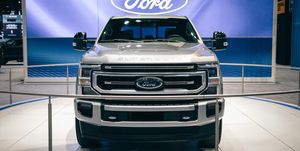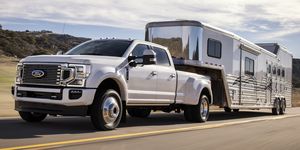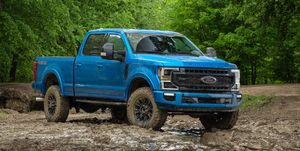The brutally competitive one-upmanship that defines the heavy-duty pickup segment pretty much ensures that the latest is going to be the greatest. For the moment, that’s the updated 2020 Ford F-series Super Duty and its key class-leading stats, including 1050 lb-ft of diesel torque and a 37,000-pound maximum towing capacity. A host of technology improvements has been added, as has an impressive off-road package, even if these behemoths aren’t the best suited for hard-core trail work. That Ford’s big rig can now conquer gnarly rock crawls, hill climbs, and mud bogs—without sacrificing much of its usefulness as a heavy-duty truck—underscores how capable it really is.
Hit the Dirt
This wasn’t the first time we’ve been well off the beaten path in a heavy-duty truck. The similarly off-road-capable Ram Power Wagon has been around for years as a standalone model in the 2500 HD lineup. But it only comes only with a 410-hp 6.4-liter gas V-8 and when coupled with the long-travel suspension, the Power Wagon’s limits of 1510 pounds hauling and 10,350 pounds towing are less than some half-ton pickups. Ford took a different tack with the Super Duty’s new-for-2020 Tremor option package. For $3975, the package adds significant off-road hardware to most crew-cab four-wheel-drive F-250 and F-350 models with the shorter of the two available bed lengths. (The package is available on all trim levels except the base XL and top-spec Limited.) More importantly, the package can be paired with either Ford’s all-new 7.3-liter gas V-8 or the PowerStroke 6.7-liter turbo-diesel, making it the only factory-backed bro dozer on the market. Maximum payload (4210 pounds) and towing (21,900 pounds) capacities remain the same as non-Tremor versions, and even the least capable configuration can tug 15,000 pounds.
As part of the revisions for the 2020 model year, conventional Super Duty models sit an inch or so lower to make climbing aboard and hitching up a trailer a little easier. The Tremor, however, benefits from roughly a two-inch lift in front and a slight raise in back. Its imposing stance means business, and, combined with a 5.0-inch shorter front air dam, allows the truck to approach taller obstacles and steeper inclines without scuffing its nose. Ground clearance is a sizable 10.8 inches. While the Tremor package doesn’t add disconnecting anti-roll bars and a locking front differential like on the Power Wagon, it does include limited-slip front and locking rear diffs, larger twin-tube off-road dampers, updated drive modes with a low-speed off-road cruise-control system, and knobby 35-inch Goodyear Duratrac all-terrain tires mounted on 18-inch wheels.
There’s no hiding the Tremor’s girth on the trail, but it does clamber over boulders and through deep ditches impressively well for a full-size pickup with a 159.8-inch wheelbase. Skid plates under the transfer case and fuel tank, as well as optional off-road running boards, help protect its underside if it gets hung up on rocks or Mazda Miatas. Thanks to the upgraded differentials and massive Goodyears, it climbs impossibly steep hills and plows through thick mud with ease, and we can verify the Blue Oval’s claim that it can ford nearly three feet of water and muck. If you think you still might get stuck, Ford will offer an optional ($3000) 12,000-pound Warn winch with a wireless controller later this year that fits behind the Tremor’s front bumper. We just wish Ford had added a handy full-time automatic four-wheel-drive mode, as seen on the latest Chevy Silverado HD and GMC Sierra HD trucks.
Moving the Metal
On the road, the Tremor’s huge off-road–oriented tires are surprisingly quite at speed. And they do nothing to help the truck’s already vague and rather loose on-center steering feel. This generation of Super Duty debuted for 2017, and Ford’s latest updates amount to a mid-cycle refresh rather than the full redesigns that GM and Ram’s heavy-duty trucks have recently undergone. But even in their least street-friendly tune, Ford’s big pickups remain highly accommodating, with good highway tracking, pleasantly hushed interiors, and decent ride quality with minimal bucking over bumps.
Ford’s improvements are far more significant under the hood, particularly with the optional PowerStroke diesel V-8 that has been massaged to produce a 475 horsepower at 2800 rpm and an absurd 1050 lb-ft of torque at 1600 rpm—increases of 25 horses and 115 lb-ft. A new 10-speed automatic that weighs only about four pounds more than last year’s six-speed is the only transmission choice here, with the bundle costing a dear $10,495. Put simply, the PowerStroke is a highly refined if expensive brute, delivering good responses to pedal inputs and minimal diesel clatter for its considerable size and output—not to mention more grunt than most buyers will ever need.
Almost as impressive is the new pushrod 7.3-liter gas V-8, which pumps out 430 horsepower at 5500 rpm and 475 lb-ft at 4000 revs. It, too, is bundled solely with the 10-speed transmission as a far more palatable upgrade ($2045) over the carryover 6.2-liter gas V-8 (385 horses and 430 lb-ft) and six-speed automatic. While it definitely works harder than the ridiculously powerful PowerStroke, this big V-8 emits a satisfyingly deep growl and is more than capable of moving a moderately loaded Super Duty at a healthy pace. We struggle to rationalize spending the significant upcharge for the diesel over the 7.3-liter unless you regularly tow ten tons.
Get to Work
All of the diesel and 7.3-liter trucks we drove were four-wheel-drive, single-rear-wheel crew cab models that weighed close to four tons. Yet, aided by the smart-shifting 10-speed, which can rifle through its closely spaced ratios to keep either engine spinning strong, both setups feel quite quick in an unladen truck. Ford says it limits the diesel’s torque in the 10-speed’s first and second gears for long-term durability, but it’s impossible to notice with so much twist on tap. The new transmission has a wider ratio spread versus the previous six-speed, including three overdrive gears for more relaxed cruising, as well as optional provisions for a power-takeoff unit to drive the hydraulics for equipment such as a snowplow or salt spreader.
Shift quality is a bit smoother with the less powerful 7.3-liter than with the PowerStroke, yet both powertrains work well tugging a trailer. A 19-foot off-road camper, complete with a beefy suspension and an articulating conventional hitch setup, made for an ideal overland package behind a F-250 Tremor with the gas V-8, which was able to pull the 7500-pound load up and down steep grades with only modest strain. Heightened noise from the engine and tempered acceleration were the only indicators that the trailer was even back there. Activating the truck’s Tow/Haul mode relaxes the steering action in models equipped with Ford’s optional variable-ratio steering system, as well as alters the programming of the 10-speed so it shifts firmer and holds gears longer.
The optional diesel engine’s prodigious torque was evident when we matted the right pedal in an F-350 hooked up to a 33-foot fifth-wheel camper weighing about 12,000 pounds. The truck shrugged off that ankle weight with little effort and shot forward with enough power in reserve to easily accelerate up hills with small prods of the pedal. Toggling both the Tow/Haul setting and the exhaust brake on the center stack prompt the 10-speed to share more of the work, most significantly by providing a significant amount of engine braking when descending grades. While the transmission generally wasn’t overly firm when paired with the diesel, we did notice a couple of disconcertingly rough downshifts that shook the whole truck while towing the big camper.
We didn’t haul anything in the new Super Duty’s bed, but certain versions are capable of carrying payloads up to 7850 pounds. Nor were we able to drive the F-450 model with a gooseneck construction trailer loaded up to the truck’s maximum capacity, 37,000 pounds. That’s because we’re not long-haul truckers and don’t have the commercial driver’s license such loads (and Ford’s legal team) genrally require. The maximum rating with a fifth-wheel setup is 32,500 pounds and you can drag up to 24,200 pounds from the conventional hitch.
Additional new towing features include Ford’s Pro Trailer Backup Assist and Trailer Reverse Guidance systems, complete with a secondary steering knob on the dash, which takes some getting used to but ultimately works well when used with the available array of exterior camera views spying on the trailer. It’s similar to the system on the light-duty F-150 but with a couple of additional camera views, including one that keeps tabs on a fifth-wheel or gooseneck attachment in the bed, and a split-view setup that looks down both sides of the trailer. Ford, however, still lags behind GM in this regard since none of the Super Duty’s trailer camera views can be accessed while moving forward the way they can in the new Silverado HD and Sierra HD.
Upping its Bar
The spacious and highly functional interior of the 2020 F-series Super Duty largely carries over, which means it’s starting to look a bit dated. Its fit and finish are not up to the standard set by newer competitors, notably Ram’s. The range-topping Limited trim, however, does receive a significant refurnishing, with supple leather upholstery, attractive contrast stitching, and nicer trim materials on the dash, doors, and center console. You’ll pay for its swankiness, though, with the well-equipped F-250 version we drove costing an eye-popping $88K. Opt for a loaded crew-cab F-450 Limited and the ask will almost crack six figures—a far cry from the base F-250’s $35,300 starting price. Figure around $70,000 for a mid-level Lariat crew cab with the diesel and four-wheel drive.
There’s also now a standard Wi-Fi hotspot, available wireless device charging, and additional standard driver assists on XLT models and above, including automatic forward emergency braking and lane-departure and blind-spot monitors. If history is any guide, the updated Super Duty’s reign within its segment will be short lived, and its improvements will do little to sway the minds of its competitors’ fiercely loyal fans. With the addition of the Tremor off-road package, however, its rivals may literally have to knock it off its mountain to top its breadth of capability.
Source: Reviews - aranddriver.com






